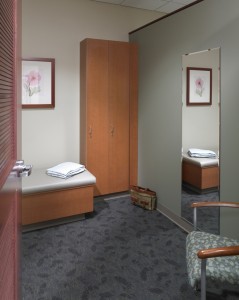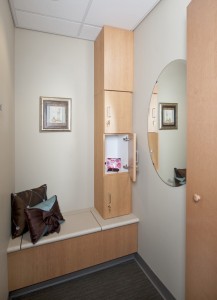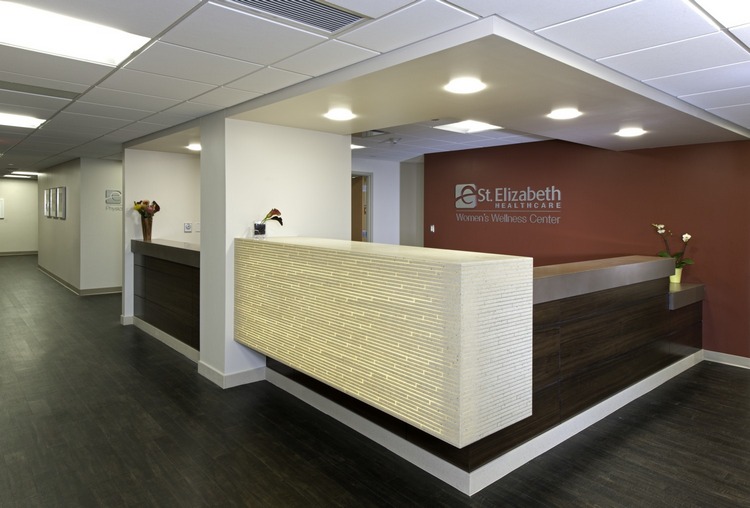Women’s health matters and the facilities that support the delivery of women’s services impact the care and results. I have a passion for women’s health having worked on the majority of Array’s women’s projects over the course of my 30-year career.

I have both personally and professionally witnessed the evolution from the traditional, multi-room delivery process to single-room, family centered care. I have also enthusiastically seen the application of these family centered values to all aspects of inpatient care. And, consistent with population trends, I recognize the benefit of a women-centered approach to non-obstetrical women’s services.
Women have unique needs and with new policies governing family planning and reproductive health, health systems have been paying close attention and anticipating the potential increase in access to care.
Obstetrics: A Family Centered Service
It was and still is thought that obstetrics is the perfect entre into the healthcare system. With women as decision makers, a positive obstetrical experience often yields loyal healthcare consumers for life. Healthcare facility design supports a positive experience. Pregnancy and the birth of a child are unique life events eliciting joy, hope and optimism for the future. They also present the opportunity to engage mothers, as well as the whole family, in health and wellness lifestyle choices. An innate human trait is for all expectant and new mothers to want to do what is best for their child and family.
Healthcare institutions often capitalize on these family planning experiences when patients are receptive to new information and guidance. These moments are great opportunities to educate women and families, improve obstetrical and neonatal outcomes and, perhaps, improve the health of our communities. Family centered facility design can support these moments when the inpatient is receptive to learning.
Specific to obstetrics, considerate design of the postpartum environment with private family rooms, dedicated family space within the rooms, amenities and opportunity for control and privacy are essential. Room amenities may include: a daybed, which serves as sleeping surface for a significant other during the night and family member or sibling comfort area during the day; surfaces that accommodate and charge laptops and personal devices and in-room refrigerator to support individual food preferences. Integrated education/entertainment TV system, controlled from the mother’s bed, can allow learning on the mother’s schedule. Individual room thermostats, lighting controls and window shade devices provide comfort and control of the environment. A baby-bath sink with sloped side and heat lamp allows mother to experience and gain comfort in bathing the newborn. While it is desirable to locate a holding or well-baby nursery on the unit, the ideal is for the infant to be in the room with the family, with nursing support available as necessary to enable bonding, breast feeding on-demand and allow the new parents to gain confidence in caring for their newborn.

Health Management: Reproductive Health and Obstetrics
Many hospitals see a high percentage of Medicaid obstetrical patients with their care covered during pregnancy and immediately thereafter. With implementation of the Affordable Care Act and at the discretion of the individual states, this need for care will expand with the affordability of health coverage. In addition to family planning and pregnancy care, insurance coverage expansion may create an increase in demand for women’s primary and preventive healthcare.
While there has been a decline in the birthrate for women of childbearing age (15-44) from a high of 122 in 1957 to 63 in 2012, family planning support, pre-natal and obstetrical services may all be on the rise, much of which can be delivered in the outpatient setting. However one feels about the ACA from a political standpoint, it is believed that access to care will positively impact not only access to family planning but pregnancy complications, including cesarean section rates and neonatal admissions, which will ultimately impact societal healthcare costs over time.
The Aging Population
The aging of the population will increase demand for care to address and manage midlife and geriatric health needs. This demand will create the need for comprehensive ambulatory services for women of all ages with provision to manage primary care, preventive health, routine gynecological care, health screenings, as well as specialty care. As stated in The Advisory Board Company’s Women’s Services: Strategic Outlook Publication 2012, “To succeed under new payment models, organizations must engage patients beyond discrete care episodes to achieve desired outcomes. Service lines such as women’s programs must not only provide high quality, low cost inpatient care, but they must also work with patients in outpatient settings to manage recovery and chronic conditions.”
Woman-Centered Care
The ability to engage women as active participants in their health, with offerings in branded centers offering comprehensive services, presents an opportunity for healthcare provider differentiation in a competitive environment with the goal of attracting loyal customers eager to assume responsibility for their personal health and wellness. The spectrum of services may include woman-specific services such as gynecology, pelvic floor disorders, gynecologic oncology, breast health, bone health and menopause support. Healthcare entities may also develop women-specific programs for cardiovascular health, nutrition and diabetes, digestive health and behavioral programming including mood disorders, anxiety, weight management, stress management, etc. Population need and organizational strategy will factor in determining specific offerings. While it is not essential to provide all services in all locations, a strong foundation and network of offerings built on a culture of woman-centered care is essential.
According to Diana Domenica Bruno, senior principal, Una Vita, the foundations of woman-centered care include:
- Philosophy: Woman-centered care is the foundation for women’s health and well-being. Women have a unique set of interrelated and gender-specific biological, psychological and spiritual needs, which guide the nature, course and duration of therapies.
- Mission: Organizational values, beliefs and practice reflect a commitment to a women’s-centered approach to healthcare and serve as the principle force in clinical, educational and operational decision making.
- Continuum of Care: Individualized gender-specific care offered along a wellness continuum considering age, ethnicity, community culture and the economic environment.
- Practice: A knowledgeable interdisciplinary professional team collaborating to promote women’s health and respond to illness.
- Decision Making: Woman-centered care recognizes and values a partnership between women and health management providers.
- Access: Programs are conveniently located and provide women a continuum of health and wellness options. Women help determine services, location and facility design features.
- Education: Woman-centered programs provide knowledge and facilitate thoughtful decision making.
- Value: Value of service is defined through assessing consumer satisfaction, program reputation and other qualitative factors along with clinical and financial measurements.
- Quality: A performance report provides women with meaningful information on customer service, outcomes and costs.
- Research: Practice reflects gender-specific research.
With enhancements in technology and the ever-increasing use of technology, “virtual” programs with care provided in multiple locations and coordinated by the provider /women’s health navigator are possible. Customers are increasingly comfortable with electronic access and online support, however, the need for facility-based outpatient care with integrated services for women remains. While geographic needs assessment and organizational-specific programming is essential, institutions should consider the following:
- Program relationships, synergies and required adjacencies for performance excellence
- Incorporation of new technologies and research
- The need for educational and community resource functions
- Appropriate alternative services including integrative medicine, acupuncture, etc.
- Desired facility amenities
One example of a women-centric practice is the Rittenhouse Women’s Wellness Center, with two sites in the Philadelphia, Pa. region. The practice advocates “an integrated approach to improving health and preventing disease exclusively for women” supported by a multidisciplinary team of women healthcare professionals providing adult primary care, including internal medicine and routine gynecology, nutritional care, medical and aesthetic skin care, emotional well-being and fitness. Other wellness programs include osteopathic manipulation medicine, acupuncture and medically based wellness packages specifically tailored to an individual need with potential focus on cholesterol, hypertension, diabetes, fatigue, irritable bowel disease, menopause and bone health.
The center’s philosophy is “A medical practice where the doctor gets to know you, is accessible, and offers same day sick appointments.” The center has invested in an electronic health record system with a patient portal, electronic prescription capability and email communication facilitating ease of patient provider communication. The center’s facilities are comfortable, calm, quiet and afford privacy and dignity.
These spaces inspire me to continue what I know to be important work— creating beautiful, healing environments which contribute positively to the practice’s business goals.





